The Roundhouse
Allow me to aggravate you with the following
dreary tale: Open House is a scheme whereby buildings in London that are
usually closed outright or otherwise restricted to the public let people
in over the course of a late September weekend to nose around (within reason).
It was by such means that I was finally able to breach the outer walls of
the Roundhouse in Chalk Farm, former concert venue for PF and their contemporaries.
I'd like to say it was on a par with a religious experience, but as it wasn't
I can't. Nevertheless, it was still good to wander by and wonder at how
anything at all ever got going in there. Reports of how agonisingly noisy,
cold and unpleasant it was as a venue sprang to mind as I paced up and down;
even with less than 50 people making a not very loud sound at all (save
a woman's baby and her three other kids either screaming or manipulating
some balloons to make that irritating squeaky noise), it was still giving
me severe acoustic trauma. As we plodded round, guided by the on-site health
and safety officer - who happened to be on crutches owing to being neither
healthy nor safe - I'm sure you'll be rapturous to know that at least three
people in the particular group I happened to find myself in mentioned Pink
Floyd in conversation. The safety officer wasn't one of them. Nor was I, come
to that. It's not something anyone ought to be forced into admitting they
have a passing regard for in public. Being a former railway turntable shed,
there were more train enthusiasts and architecture types clambering about
than music fans. Thus it was that while we were standing on a balcony at
the building's edge, looking down at the floor and up at the wooden roof,
a train spotterish type launched into an impassioned monologue about the ironwork
supports holding the roof up. I can't deny it; it was a bit dull even by
my standards. The only bit of the place we didn't get to see was the basement
which used to house the mechanism for the turntable. Apparently it's all
arched and crypt-like, and has a special name which I can't remember. After
a bit more wandering round, as one is wont to do in a building that's exclusively
circular, I bade farewell to the woman with the noisy children, who talked
to me every so often throughout the visit - not that I minded in the slightest,
especially as she seemed to have come to the conclusion that I was in some
way intelligent and personable despite having done nothing to prove it to
her. Incidentally she looked like Capital Radio DJ Margherita Taylor and
sounded like actress Jaye Griffiths, which for nearly everybody reading this
will mean approximately sod all. Never mind. Anyway I said goodbye to her
and emerged, blinking in the sunlight, to the outside world once more.
And so to the pictures. But don't get too
excited.
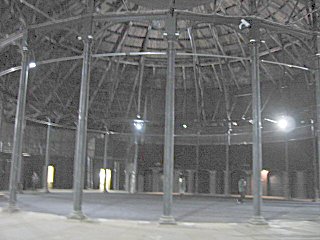
A general view from the floor. Out of focus,
dark and a bit crooked. It's *free* though, so shut your trap and lump
it.
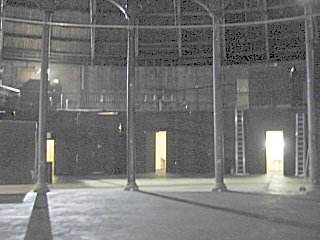
Now, that over there is where the stage
was, taken from near enough the middle of the floor area. You can just about
see where it comes in the grand scheme of things in the picture above. Obviously
it's not the actual original stage - that was apparently a platform only
a few feet high. I think that those three shafts of light are storage cupboards
or a backstage area of some description for shows put on nowadays. In any
case, they themselves follow the contour (is that the word?) of the circular
wall, and just off camera on both the left and right are two 'jaws' that
jut out. I've not described that very well at all. Oh well.
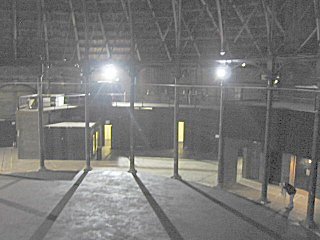
Does this help any? From this angle you
can still see two of the shafts of light coming from two of the doorways
to the storage cupboards and/or backstage area, plus the left-hand 'jaw' thing
jutting out at a right angle to the wall of the building. The right-hand jaw's
obscured by the angle, the darkness and the man bent over in a manner liable
to give him chronic backache unless he straightens himself up.
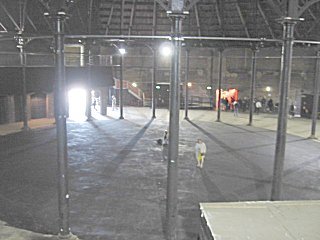
So, as you may have surmised, it's possible
to get above floor level. And this shows you what nearly all of the place
looks like from such a vantage point. What I'm standing on top of is the
right-hand jaw (from the audience's point of view) of the stage area. You
might also be able to spot the rest of the balcony on the left and the red-painted
stairs to/from it. Nimble minds will deduce that it's from there that I
took the picture above. That strange orange glowing bit over to the right
is merely an exhibition detailing future plans for the place, not a small
fire. Furthermore, the shaft of bright daylight is the original entrance
for the steam engines that used to live here - until their replacements were
built, with cavalier disregard for the size of the entrance. But they were
too big, so that's how it was made redundant as an engine shed....
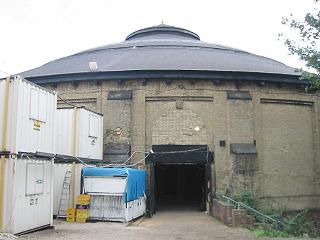
You don't believe me, do you? Well, it's
true. You can more or less see how little room they had to play with from
this, which is what the famous entrance looks like from the outside. Even
though its top third has been bricked up since, it's still not much of
a gap to squeeze a huge locomotive through. I have a dim memory of being
told that they were too long to fit on the turntable as well, which is even
more woeful - and the kind of elementary mistake most Britons think could
only happen on the railways today. Casting a veil over such incompetence,
allow me to point out the stairs on the right leading down to the basement
where the turntable mechanism used to live, and the current offices of the
venue on the left, tastefully disguised as freight containers.
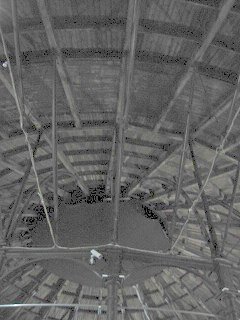
Well, let me see. We've been inside. We've
been upstairs. We've been outside. Where haven't we been yet? This is a
pointless preamble, isn't it? You can see where we're bound. Yes, the roof.
Supported by a rather rusty-looking ironwork network of girders, it's more
or less completely wooden. But back in its engine shed days, it never used
to be - some of it was made of glass. What is hopefully apparent are the
different directions of the wood. Nearer the centre, up to the apex of
the roof, you can see the planks are vertically arranged, farther out they're
horizontally arranged, and then they go back to being vertical again. As
far as I remember, the vertical planks near the apex were where the glass
used to be, and the black circle hides the air vent. Don't forget, the
steam locomotives belched out a lot of steam and thick, black smoke. So
the vent used to rid the place of the permanant fog, and the glass let
in a semblance of daylight so oilers and greasers could actually see what
they were doing.
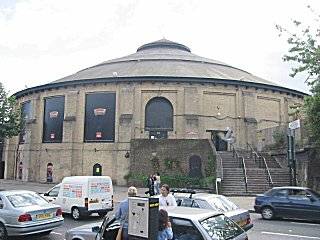
You may have already seen this one at another
time and another place, but I'll sling it in here to round off anyway. From
Chalk Farm Road, and more accurately still from the forecourt of the petrol
station opposite, this is what the place looks like. It's big, round, shaped
like a house and beautifully proportioned. Ladies and Gentlemen, I give
you the Roundhouse. And say hello to Norman the pigeon, who swept by just
as I pressed the shutter button. Crafty sod.
Another piss-poor, shabby production
hastily done from memory alone and thus probably full of inaccuracies by
CJH.






